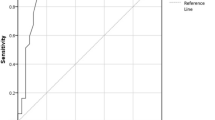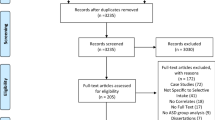Abstract
The current study investigated toileting problems in one hundred and twenty-seven children and adolescents with parent-reported diagnoses of autism spectrum disorder. Toileting refers to the accomplishment of various unprompted behaviors, including recognising the need to go to the toilet, and waiting before eliminating. The relationship between toileting problems and age, gender, intellectual disability, gastrointestinal symptoms, sleep problems, comorbid psychopathology, quality of life, and adaptive functioning were examined using parent-report questionnaires. The most common toileting problems were, “Does not independently perform most self-help tasks”, “Has toilet accidents during the day”, and “Parent/caregiver notices smears in underwear”. Gender, presence of intellectual disability, gastrointestinal symptoms, and comorbid psychopathology were significant predictors of toileting problems in this study. The gastrointestinal symptoms of constipation and bloating were found to be significant predictors of toileting difficulties. Specifically, constipation predicted accidents and physical problems associated with toileting, and bloating predicted social/emotional factors and physical problems. A small negative correlation was observed between total toileting problems and total health related quality of life. An increase in physical toileting difficulties was associated with lower quality of life.

Similar content being viewed by others
References
American Psychiatric Association. (2013). Diagnostic and statistical manual of mental disorders (5th ed.). Washington, DC: American Psychiatric Association.
Autism Treatment Network. (2005). GI symptom inventory questionnaire, version. 3.0. New York: Autism Speaks.
Belva, B., & Matson, J. L. (2013). An examination of specific daily living skills deficits in adults with profound intellectual disabilities. Research in Developmental Disabilities, 34, 596–604.
Belva, B., Matson, J. L., Barker, A., Shoemaker, M. E., & Mahan, S. (2011). The relationship between adaptive behavior and specific toileting problems according to the profile of toileting issues (POTI). Research in Developmental Disabilities, 23, 535–542.
Community-University Partnership for the Study of Children, Youth, and Families. (2011). Review of the Vineland Adaptive Behavior Scales-Second Edition (Vineland-II). Edmonton: Community-University Partnership for the Study of Children, Youth, and Families.
Cox, D. J., Morris, J. B., Borowitz, S. M., & Sutphen, J. L. (2002). Psychological differences between children with and without chronic encopresis. Journal of Pediatric Psychology, 27, 585–591.
Darymple, N. J., & Ruble, L. A. (1992). Toilet training and behaviors of people with autism: parent views. Journal of Autism and Developmental Disorders, 22(2), 265–275.
Duncan, D., Matson, J. L., Bamburg, J. W., Cherry, K. E., & Buckley, T. (1999). The relationship of self-injurious behavior and aggression to social skills in persons with severe and profound learning disability. Research in Developmental Disabilities, 20(6), 441–448.
Foxman, B., Valdez, R. B., & Brook, R. H. (1986). Childhood enuresis: prevalence, perceived impact, and prescribed treatments. Pediatrics, 77(4), 482–487.
Francis, K., Mannion, A., & Leader, G. (2017). The assessment and treatment of toileting difficulties in individuals with autism spectrum disorders and other developmental disabilities. Review Journal of Autism and Developmental Disorders, 4, 190–204.
Goldman, S. E., McGrew, S., Johnson, K. P., Richdale, A. L., Clemons, T., & Malow, B. A. (2011). Sleep is associated with problems behaviors in children and adolescents with autism spectrum disorder. Research in Autism Spectrum Disorders, 5, 1223–1229.
Gorrindo, P., Williams, K. C., Lee, E. B., Walker, L. S., McGrew, S. G., & Levitt, P. (2012). Gastrointestinal dysfunction in autism: parental report, clinical evaluation, and associated factors. Autism Research, 5(2), 101–108.
Hattier, M. A., Matson, J. L., Belva, B. C., & Horowitz, M. (2011). The occurrence of challenging behaviors in children with autism spectrum disorders and atypical development. Developmental Neurorehabilitation, 14(4), 221–229.
Issenman, R. M., Filmer, R. B., & Gorski, P. A. (1999). A review of bowel and bladder control development in children: how gastrointestinal and urologic conditions relate to problems in toilet training. Pediatrics, 103(3), 1346–1352.
Joinson, C., Heron, J., Butler, U., & Von Gontard, A. (2006). Psychological differences between children with and without soiling problems. Pediatrics, 117(5), 1575–1584.
Keen, D., Brannigan, K. L., & Cuskelly, M. (2007). Toilet training for children with autism: the effects of video modeling. Journal of Developmental and Physical Disabilities, 19, 291–303.
Kuhlthau, K., Orlich, F., Hall, T. A., Sikora, D., Kovacs, E. A., Delahaye, J., & Clemons, T. E. (2010). Health related quality of life in children with autism spectrum disorders: results from the autism treatment network. Journal of Autism and Developmental Disorders, 40, 721–729.
Kuhlthau, K., Kovacs, E., Hall, T., Clemmons, T., Orlich, F., Delahaye, J., & Sikora, D. (2013). Health-related quality of life for children with ASD: associations with behavioral characteristics. Research in Autism Spectrum Disorders, 7, 1035–1042.
Landman, G. B., Rappaport, L., Fenton, T., & Levine, M. D. (1986). Locus of control and self-esteem in children with encopresis. Developmental and Behavioral Pediatrics, 7(2), 111–113.
Lohmann, W., Eyman, R. K., & Lask, E. (1967). Toilet training. American Journal of Mental Deficiency, 71(4), 551–557.
Mannion, A., Brahm, M., & Leader, G. (2014). Comorbid psychopathology in autism spectrum disorder. Review Journal of Autism and Developmental Disorders, 1(2), 124–134.
Mannion, A., & Leader, G. (2013). Comorbidity in autism spectrum disorder: a literature review. Research in Autism Spectrum Disorders, 7(12), 1595–1616.
Mannion, A., Leader, G., & Healy, O. (2013). An investigation of comorbid psychological disorders, sleep problems, gastrointestinal symptoms and epilepsy in children and adolescents with autism spectrum disorder. Research in Autism Spectrum Disorders, 7, 35–42.
Maskey, M., Warnell, F., Parr, J. R., Le Couteur, A. L., & McConachie, H. (2012). Emotional and behavioral problems in children with autism spectrum disorder. Journal of Autism and Developmental Disorders, 43, 851–859.
Matson, J. L., Dempsey, T., & Fodstad, J. C. (2010). The profile of toileting issues (POTI). Baton Rouge: Disability Consultants, LLC.
Matson, J. L., & Gonzalez, M. L. (2007). Autism spectrum disorders – Comorbidity – Child version. Baton Rouge: Disability Consultants, LLC.
Matson, J. L., & LoVullo, S. V. (2009). Encopresis, soiling and constipation in children and adults with developmental disability. Research in Developmental Disabilities, 30(4), 799–807.
Matson, J. L., Horovitz, M., & Sipes, M. (2011a). Characteristics of individuals with toileting problems and intellectual disability using the profile of toileting issues (POTI). Journal of Mental Health Research, 4, 53–63.
Matson, J. L., Neal, D., Hess, J. A., & Kozlowski, A. M. (2011b). Assessment of toileting difficulties in adults with intellectual disabilities. An examination using the profile of toileting issues (POTI). Research in Developmental Disabilities, 32, 176–179.
Matson, J. L., LoVullo, S. V., Rivet, T. T., & Boisjoli, J. A. (2009). Validity of the autism spectrum disorder-comorbid for children (ASD-CC). Research in Autism Spectrum Disorders, 3(2), 345–357.
Mazefsky, C. A., Schreiber, D. R., Olino, T. M., & Minshew, N. J. (2014). The association between emotional and behavioral problems and gastrointestinal symptoms among children with high functioning autism. Autism, 18(5), 493–501.
Mazurek, M. O., Vasa, R. A., Kalb, L. G., Kanne, S. M., Rosenberg, D., Keefer, A., et al. (2013). Anxiety, sensory over-responsivity, and gastrointestinal problems in children with autism spectrum disorders. Journal of Abnormal Child Psychology, 41(1), 165–176.
McElhanon, B. O., McCracken, C., Karpen, S., & Sharp, W. G. (2014). Gastrointestinal symptoms in autism spectrum disorder: a meta-analysis. Pediatrics, 133(5), 872–883.
Oliver, C., & Richards, C. (2010). Self-injurious behavior in people with intellectual disability. Current Opinion in Psychiatry, 23(5), 412–416.
Owens, J. A., Nobile, C., McGuinn, M., & Spirito, A. (2000). The children’s sleep habits questionnaire: construction and validation of a sleep survey for school-aged children. Sleep, 23(8), 1043–1051.
Owens-Stively, J. A. (1987). Self-esteem and compliance in encopretic children. Child Psychiatry and Human Development, 18(1), 13–21.
Pierce, K. L., & Schreibman, L. (1994). Teaching daily living skills to children with autism in unsupervised settings through pictorial self-management. Journal of Applied Behavior Analysis, 27, 471–481.
Richdale, A. (2001). Sleep disturbance in children and adolescents with disorders of development: Its significance and management. London: Cambridge University Press.
Richdale, A. L., & Schreck, K. A. (2009). Sleep problems in autism spectrum disorders: prevalence, nature, & possible biopsychosocial aetiologies. Sleep Medicine Reviews, 13(6), 403–411.
Schum, T. R., Kolb, T. M., McAuliffe, T. L., Simms, M. D., Underhill, R. L., & Lewis, M. (2002). Sequential acquisition of toilet-training skills: a descriptive study of gender and age differences in normal children. Pediatrics, 109(3), 48–54.
Shahid, A., Wilkinson, K., Marcu, S., & Shapiro, C. M. (2012). STOP, THAT and One Hundred Other Sleep Scales, Chapter 31: FACES (Fatigue, Anergy, Consciousness, Energy, and Sleepiness). Springer Science+ Business Media, 200, 155-156.
Simonoff, E., Pickles, A., Charman, T., Chandler, S., Loucas, T., & Baird, G. (2008). Psychiatric disorders in children with autism spectrum disorders: prevalence, comorbidity and associated factors in a population-driven sample. Journal of the American Academy Child and Adolescent Psychiatry, 47(8), 921–929.
Smith, P. S., & Smith, L. J. (1977). Chronological age and social age as factors in intensive daytime toilet training of institutionalized mentally retarded individuals. Journal of Behavior Therapy and Experimental Psychiatry, 8(3), 269–273.
Sparrow, S. S., Cicchetti, D. V., & Balla, D. A. (2005). Vineland Adaptive Behavior Scales (2nd ed.). Circle Pines: American Guidance Service.
Szyndler, J. (2007). Toileting problems in a group of children with autism. Child and Adolescent Mental Health, 1(1), 19–25.
Taylor, A. M., Schreck, K. A., & Mulick, J. A. (2012). Sleep disruption as a correlate to cognitive and adaptive behavior problems in autism spectrum disorders. Research in Developmental Disabilities, 33(5), 1408–1417.
Taubman, B. (1997). Toilet training and toileting refusal for stool only: a prospective study. Pediatrics, 99(1), 54–58.
Van der Wal, M. F., Benninga, M. A., & Hirasing, R. A. (2005). The prevalence of encopresis in a multicultural population. Journal of Pediatric Gastroenterology and Nutrition, 40(3), 345–348.
Varni, J. W., Seid, M., & Kurtin, P. S. (2001). PedsQL™ 4.0: reliability and validity of the pediatric quality of life inventory™ version 4.0 generic core scales in healthy and patient populations. Medical Care, 39(8), 800–812.
Varni, J. W., Seid, M., & Rode, C. A. (1999). The PedsQL (TM): Measurement model for the pediatric quality of life inventory. Medical Care, 37(2), 126–139.
Williams, K. C., Christofi, F. L., Clemmons, T., Rosenberg, D., & Fuchs, G. J. (2012a). Association of chronic gastrointestinal symptoms with sleep problems may help identify distinct subgroups of autism spectrum disorders. Gastroenterology, 142(5), (Suppl.1)), S-714.
Williams, K. C., Christofi, F. L., Clemmons, T., Rosenberg, D., & Fuchs, G. J. (2012b). Chronic GI symptoms in children with autism spectrum disorders are associated with clinical anxiety. Gastroenterology, 142(5), (Suppl. 1)), S-79–S-80.
Williams, K. C., Fuchs, G. J., Furuta, G. T., Marcon, M. A., & Coury, D. L. (2010). Clinical features associated with GI symptoms in autism spectrum disorders (ASD). Gastroenterology, 138(5), (Suppl. 1)), S-74.
Funding
This study did not receive research funding.
Author information
Authors and Affiliations
Corresponding author
Ethics declarations
Ethical Approval
No animals were involved in this study. This research received full ethical approval form the National University of Ireland Galway. The study followed all procedures in accordance with the ethical standards of our University and with the 1964 Helsinki declaration and its later amendments or comparable ethical standards.
Informed Consent
Informed consent was obtained from all participants in this study.
Conflict of Interest
The authors declare that they have no conflict of interest.
Rights and permissions
About this article
Cite this article
Leader, G., Francis, K., Mannion, A. et al. Toileting Problems in Children and Adolescents with Parent-Reported Diagnoses of Autism Spectrum Disorder. J Dev Phys Disabil 30, 307–327 (2018). https://doi.org/10.1007/s10882-018-9587-z
Published:
Issue Date:
DOI: https://doi.org/10.1007/s10882-018-9587-z




